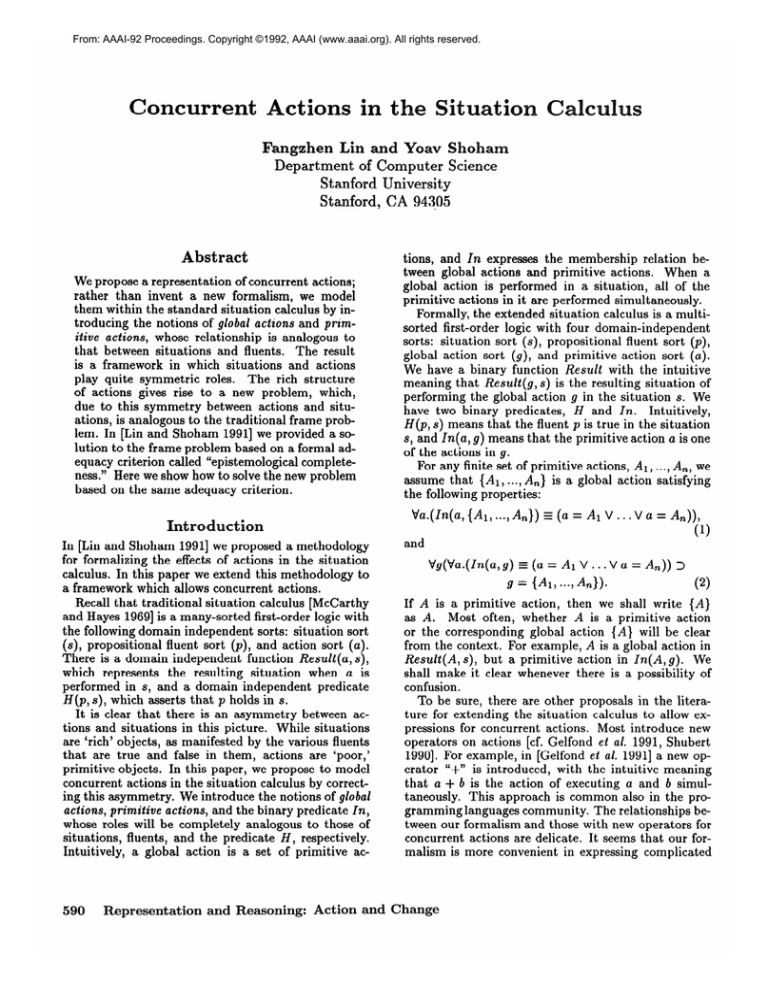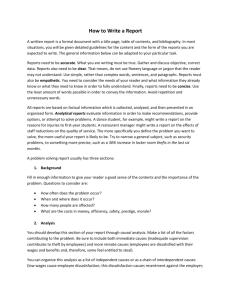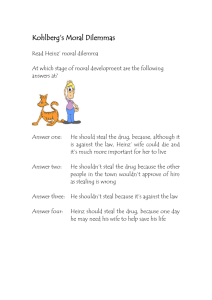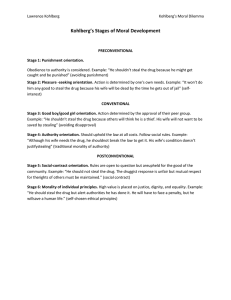
From: AAAI-92 Proceedings. Copyright ©1992, AAAI (www.aaai.org). All rights reserved.
Concurrent Actions in t
Fang&en Lin and Uoav Shoharn
Department of Computer Science
Stanford University
Stanford, CA 94305
Abstract
We propose a representation of concurrent actions;
rather than invent a new formalism, we model
them within the standard situation calculus by introducing the notions of global actions and primitive actions, whose relationship is analogous to
that between situations and fluents. The result
is a framework in which situations and actions
play quite symmetric roles. The rich structure
of actions gives rise to a new problem, which,
due to this symmetry between actions and situations, is analogous to the traditional frame problem. In [Lin and Shoham 19911 we provided a solution to the frame problem based on a formal adequacy criterion called “epistemological completeness.” Here we show how to solve the new problem
based on the same adequacy criterion,
Va.(In(a,
Introduction
In [Lin and Shoham 19911 we proposed a methodology
for formalizing the effects of actions in the situation
calculus. In this paper we extend this methodology to
a framework which allows concurrent actions.
Recall that traditional situation calculus [McCarthy
and Hayes 19691 is a many-sorted first-order logic with
the following domain independent sorts: situation sort
(s), propositional fluent sort (p), and action sort (a).
There is a domain independent function ResuZt(a, s),
which represents the resulting situation when a is
performed in s, and a domain independent predicate
H(p, s), which asserts that p holds in s.
It is clear that there is an asymmetry between actions and situations in this picture. While situations
are ‘rich’ objects, as manifested by the various fluents
that are true and false in them, actions are ‘poor,’
primitive objects. In this paper, we propose to model
concurrent actions in the situation calculus by correcting this asymmetry. We introduce the notions of global
actions, primitive actions, and the binary predicate In,
whose roles will be completely analogous to those of
situations, fluents, and the predicate H, respectively.
Intuitively, a global action is a set of primitive ac-
590
Representation
and Reasoning:
tions, and In expresses the membership relation between global actions and primitive actions. When a
global action is performed in a situation, all of the
primitive actions in it are performed simultaneously.
Formally, the extended situation calculus is a multisorted first-order logic with four domain-independent
sorts: situation sort (s), propositional fluent sort (p),
global action sort (g), and primitive action sort (a).
We have a binary function Result with the intuitive
meaning that ResuZt(g, s) is the resulting situation of
performing the global action g in the situation s. We
have two binary predicates, H and In. Intuitively,
H(p, s) means that the fluent p is true in the situation
s, and In(a, g) means that the primitive action a is one
of the actions in g.
For any finite set of primitive actions, Al, . . . . An, we
assume that {Al, . . . . An} is a global action satisfying
the following properties:
{Al, . . . . An}) E (a = Al V . . . V a = An)),
(1)
and
Vg(Va.(In(a,
g) E (a = A1 V . . . V a = An)) 3
g = {AI, . . . . An}).
(2)
If A is a primitive action, then we shall write (A}
as A. Most often, whether A is a primitive action
or the corresponding global action {A} will be clear
from the context. For example, A is a global action in
ResuZt(A, s), but a primitive action in In(A,g).
We
shall make it clear whenever there is a possibility of
confusion.
To be sure, there are other proposals in the literature for extending the situation calculus to allow expressions for concurrent actions. Most introduce new
operators on actions [cf. Gelfond et al. 1991, Shubert
19901. For example, in [Celfond et al. 19911 a new operator “+” is introduced, with the intuitive meaning
that a + b is the action of executing a and b simultaneously. This approach is common also in the programming languages community. The relationships between our formalism and those with new operators for
concurrent actions are delicate. It seems that our formalism is more convenient in expressing complicated
Action and Change
actions such as the global action where every agent
makes a move.
Another way to extend the situation calculus is to
think of Result as a relation, rather than a function.
For example, we can introduce RES(a, sr, sz) with
the intuitive meaning that s2 is one of the situations
resulted from executing a, along with possibly some
other actions, in sr. This is essentially the approach
taken in [Georgeff 1986, Peleg 1987, and others]. The
drawback of this approach is that it does not explicitly list the additional actions that cause the transition
from sr to ~2. Thus Georgeff (1986) had difficulty in
formalizing the effect of a single action when performed
exclusively.
A more radically different approach to concurrency
is via temporal logic [Allen 1984, McDermott 19821.
For a comparison between the situation calculus approach to reasoning about action and that of temporal
logic, see [Pelavin and Allen 1987, Shoham 19891.
The rest of the paper is organized as follows. In
section 2 we introduce a formal criterion, called epistemological completeness,
to evaluate theories of actions. This criterion was first introduced in [Lin and
Shoham 19911 in the context of traditional situation
calculus with respect to primitive actions; the extension to global actions is straightforward. In section 3,
we show that this criterion not only help us clarify
the traditional (fluent-oriented) frame problem, as we
have done in [Lin and Shoham 19911, it also clarifies
the new action-oriented
frame problem. In section 4,
we illustrate our solution to these problems using the
well-known Stolen Car Problem. The solution is extended to a class of causal theories in section 5, and
compared to others in the context of conflicting subactions in section 6. Finally, we conclude in section
7.
Epistemologically complete theories of
action
In the situation calculus we formalize the effects of actions using first-order logic. However, as is well-known,
adopting classical semantics leads to problems such as
the frame problem, the ramification problem, et cetera.
In [Lin and Shoham 19911 we argued that the ultimate
criterion against which to evaluate theories of (primitive) actions is what we called epistemological
completeness. The various problems amount to achieving
this completeness in a precise and concise fashion. We
shall see that, when we introduce concurrency, new
problems arise. However, the notion of epistemological completeness is relevant also to their definition
and solution. This section therefore repeats some key
definitions from [Lin and Shoham 19911, appropriately
modified to the context of global actions.
In that paper, and here as well, we concern ourself
only with deterministic actions, which map a situation into a unique other one. Intuitively, a theory of
a (deterministic) action is epistemologically complete
if, given a complete description of the initial situation,
the theory enables us to predict a complete description
of the resulting situation when the action is performed.
In order to formalize this intuition, we first introduce
the notion of states, which are complete descriptions
of situations with respect to the set of the fluents we
are interested in.
In the following, let P be a fixed set of ground fluent
terms in which we are interested. This fixed set of fluents plays a role similar to that of the Frame predicate
in [Lifschitz 19901.
Definition 1 A set SS is a state of the situation S
(with respect to P) ij th ere is a subset P’ of P such
that
SS = (H(P,
S) 1 P E P’) u (yH(P,
S) 1 P E P -7”).
Therefore, if SS is a state of S, then for any P E P,
either H(P, S) E SS or lH(P, S) E SS.
Thus we can say that a first-order theory T is epistemologically complete about the global action G (with
respect to P) if it is consistent, and for any ground
situation term S, any state SS of S, and any fluent P E P, either T U SS b H(P, ResuZt(G, S)) or
T U SS j= lH(P, ResuZt(G,S)),
where b is classical
first-order entailment.
However, as is well-known, classical entailment is not
the only choice, we may also interpret our language
nonmonotonically according to a nonmonotonic entailment. Indeed, the notion of epistemological completeness is not limited to monotonic first-order theories. In
general, for any given monotonic or nonmonotonic entailment j=c, we can define epistemological completeness as follows:
Definition 2 A theory T is epistemologically complete about the action G (with respect to P, and according to kc) if T &tc FaZse, and for any ground
situation term S, any state SS of S, and any jZuend P E Q, there is a finite subset SS’ of SS such
that either T /=c /\SS
> H(P, ResuZt(G, S)) or
T /=c ASS’ I lH(P, ResuZt(G, S)).
We note that for any sets T, SS, and formula (p, TU
SS b cp if there is a finite subset SS’ of SS such that
T b A SS’ > p. Thus if we replace k= in Definition 2
by classical entailment b, we get the same definition
we have earlier for monotonic first-order theories.
The frame problems
There are a number of well-known problems in formalizing the effects of actions. The most famous one is
the frame problem [McCarthy and Hayes 19691, which
is best illustrated by an example. Consider a primitive
action Paint which paints Block10 blue:
Vs.H(C(BZoctElO, Blue), ResuZt(Paint,
s)).
(3)
The axiom tells us nothing about what happens to the
color of a red block next to BZocLlO after Paint is
Lin and Shoham
591
a single fluent, but a rich structure of actions. The
symmetry is exactly the same as the one between situations and actions in our framework.
In [Lin and Shoham 19911 we argued that a useful
way to tackle the fluent-oriented frame problem is to
consider a monotonic theory with explicit frame axioms first, and then to show that a succinct and provably equivalent representation using, for example, a
nonmonotonic logic, captures the frame axioms concisely. We shall follow the same strategy here for the
generalized frame problem. Let us illustrate it using a
version of Kautz’s stolen car problem [Kautz 19861.
iib-““iB
Figure 1: The frame problems
performed. For that, we need a so-called frame axiom
which says that the neighboring block will still be red:
Vs.(H(C(BZockS,
H(C(BZock9,
Red), s) E
Red), Result(Paint,
8))).
(4)
The frame problem is that of succinctly summarizing the frame axioms.
Formally, we can say
that the frame axiom is needed because, although
((3))
is a complete theory about Paint
w.r.t.
(C(BZockl0, Blue)},
it is not so w.r.t.
P =
(C(BZock10, Blue), C(Block9, Red)}. It is easy to see
that WI (41 is complete w.r.t. P. The frame problem, then, is concerned with achieving epistemological
completeness in a convenient way for a given set of
fluents.
In [Lin and Shoham 19911, we proposed a solution
to the frame problem for a wide class of causal theories. However, for concurrent actions, in addition to
the traditional frame problem, there is a closely related
problem.
Suppose now that we have a new primitive action
Close which closes the door.
Consider the global
Since (3) tells us nothing
action (Paint, Close).
about (Paint, Close}, we need an “inheritance axioms” which says that {Paint, Close} can inherit the
effect of Paint:
Vs.H(C(BZocklO,
BZue), ResuZt({Paint,CZose},
s)).
(5)
It is clear that, for any global action that includes
Paint, and does not include a subaction that “interferes” with Paint, we need a similar axiom. Then,
like the frame problem, we have a problem of how to
succinctly summarize these “inheritance axioms.”
Again, in terms of epistemological completeness, we
can say that the axiom (5) is needed because, although
((3)) is an epistemologically complete theory about
Paint w.r.t. (C(BZockl0,
Blue)), it is not so about
{Paint, Close}.
The new problem, then, is again
about how to achieve epistemological completeness in
a convenient way for a given set of global actions.
It is clear that the two problems are symmetric
(Fig.1). The first one, called the fluent-oriented
frame
problem, involves a rich structure of propositional fluents, but only a single primitive action. The second
one, called the action-oriented
frame problem, involves
592
Representation
and Reasoning:
The Stolen Car Problem revisited
The scenario is as follows. Initially, the car is present,
but after two waiting periods it is gone. When was it
stolen?
Suppose we have two propositional fluents Stolen
(the car is gone) and Returned (the car owner is back),
and two primitive actions: Steal and Return.
After
Return, the car owner returns:
Vs.H(Returned,
ResuZt(Return,
s)).
(6)
If the owner of the car has not returned, then after
SteaZ, the car would be stolen:
Vs.(-H(Returned,
s) 3 H(StoZen,
s))).
(0
If Return and Steal are performed simultaneously,
then the effect of Steal would be canceled:
Vs.(-H(StoZen,
--H(Stolen,
ResuZt((SteaZ,
ResuZt(SteaZ,
s) >
Return),
s))).
(8)
(Stolen, Returned).
Then, of course,
is
not
an
epistemologically
complete theU6h (7h (8))
ory of Return, Steal, and (Steal, Return).
Following the strategy in [Lin and Shoham 19911, we
shall provide two ways to complete the theory. One is
to stick to first-order logic, and supply the necessary
frame axioms and inheritance axioms explicitly. The
other one is to use a nonmonotonic logic. It is important that the two completions are equivalent.
Let P
A
=
monotonic completion
We first explicitly supply necessary inheritance axioms.
This will give us a causal theory for each global action
as defined in [Lin and Shoham 19911.
In this example, there is only one global acto consider. Because of (8),
tion, {Steal, Return},
{Steal, Return} can only inherit the effect of Return:
Vs.H(Returned,
Result((SteaZ,
Return),
s)).
(9)
Now we have a causal theory, {(6), (7), (9)), about
the three actions. We can use the technique in [Lin and
Shoham 19911 to generate necessary frame axioms.
Action and Change
For Steal,
we have the frame axioms:
Vs.(H(Returned,
H(Returned,
s) z
Result(Stea1,
Vsp.(H(Returned,
s))),
s) 9
Vs.(H(Stolen,
s))]).
Result(Return,
s))).
(12)
we have:
s) E H(Stolen,
Result((Steal,
Return),
Let Tl be the set of axioms (6) - (13). Then it is
clear that Tl is an epistemologically complete theory
of Steal, Return, and {Steal, Return}.
Furthermore,
if we assume that these are the only global actions:
Vg.(g = Steal V g = Return
V g = (Steal,
Return)),
(14)
then
Tl U {(14)}
I-
Vglg2s.(lH(Stolen,
H(Stolen,
s) A
Result(g2,
3 -rH(Returned,
TH(Returned,
ResuZt(gl,
s)))
s) A
Result(gl,
s)) A
(gl = Steal V g2 = Steal)).
That is, the owner never returned, and that Steal must
have happened during one of the waits.
A nonmonotonic completion
Although Tr gives the right answers to the stolen car
problem, it suffers from the frame problems since it
appeals to the explicit inheritance and frame axioms.
We now provide an equivalent nonmonotonic theory
that avoids them.
We introduce two auxiliary predicates.
We have
ab(p, g, s) which is true if the truth value of p changes
after g is performed in s:
bw(lab(p,
9, s) 1 (H(P, s) = H(P, Resuit(g,
s)))).
05)
We also have CanceZed(gl , g2, s) which is true if the
“normal” causal effect of the global action gl is canceled by some other actions in g2 when they are performed simultaneously in the situation s. Thus the
causal rules (6) and (7) are rewritten as:
Vgs.(In(Return,
g) A -Canceled(Return,
H(Returned,
Vgs.(In(Steal,
--H(Returned,
Result(g,
g, s) >
s))),
(16)
g, s)A
g) A 4’anceled(Steal,
s) > H(Stolen,
Result(g,
s))),
(19)
(20)
(Steal,
Return))
z
g) 3 Canceled(Stea1,
g, s)).
(21)
and the unique names assumption:
Return
# Steal A Returned
# Stolen.
(22)
s))). Then the circumscription of Canceled in T2 with H allowed to vary, written Circum(T2; Canceled; H), implies the causal rules (6), (7); and (9).
Thus, in
a sense, Circum(T2; Canceled; H) solves the actionoriented frame problem for the Stolen Car Problem.
We solve the fluent-oriented frame problem using the
solution proposed in [Lin and Shoham 19911. Specifically, we circumscribe ab in Circum(T2; Canceled; H)
according to the policy in [Lin and Shoham 19911. The
results in [Lin and Shoham 19911 show that the circumscriptive theory is equivalent to Tl U ((22)) in the
sense that for any sentence yo in the language of Tl, cp
is a first-order consequence of the circumscriptive theory iff it is a first-order consequence of Tl U { (22)).
In particular, T2 is a nonmonotonic theory that is
epistemologically complete about Steal, Return, and
{Steal, Return).
We notice that the axiom (18) does not take into account the fact that for Return to override the effect of
Steal, Return itself must not be overridden by something else such as “Murder.”
Thus a more appropriate
axiom might be:
Vgs.(In(Return,
g) A -Canceled(Return,
> Canceled(Steal,
g, s)
g, s)).
(23)
But if we simply circumscribe Canceled in the above
axiom, we shall have two minimal models, one in which
Canceled(Return,
{Steal, Return}, s) is true, and the
(Steal, Return), s) is
other in which Canceled(Stea1,
true. It is clear that we should prefer the second one.
Formally, this can be done by using prioritized subdo
main circumscription [Lifschitz 19861. But we suspect
that the formal theory will be complicated, witness
the result in [Lifschitz 19871. Notice that axioms of
the form (23) resemble rules in logic programs with
negation-as-failure. Thus it would be natural that we
use default logic to capture Canceled, and pipe the result to circumscription. Although this is perfectly welldefined, some may find it odd to use two nonmonotonic
logics at the same time. An alternative formulation of
(18) in light of Murder is the following axiom:
(17)
Vg.(In(Return,
(18)
(24)
Although (24) is not as good as (23), it should suffice
in many applications.
and (8) is replaced by
Vgs.(In(Return,
G a = Steal),
E a = Return),
a = Steal V a = Return),
s) G H(Stolen,
Return),
Steal)
Return)
Va.(In(a,
(11)
we have:
Vs.(H(Stolen,
For {Steal,
Va.(In(a,
(10)
Va.(In(a,
[H(p, s) E H(p, Result(Stea1,
For Return,
Now let T2 consist of the axioms (15) - (18), the
following instances of (1):
g)A-In(Murder,
g) 3 Canceled(Stea1,
Lin and Shoham
593
Causal theories
A nonmonotonic
We notice that both our monotonic and nonmonotonic
solutions to the Stolen Car problem are adequate in the
sense that they are epistemologically complete. Furthermore, they are provably correct with respect to
each other. In this section, we show how the solutions
can be generalized to a class of causal theories.
In the following, let P be a fixed set of propositional
fluents, and G be a fixed set of global actions. Let
Def be the instantiations of (1) and (2) to the global
actions in 6. Thus, for example, if (Al, As) E 6, then
Va.(In(a,
(Al,A2})
c a = A1 V a = AZ)
will be an axiom in Def.
A causal theory of 6 consists of a domain constraint
of the form
Vs.C(s),
(25)
a set of causal rules of the form
Vs.(R(s)
> H(P, Result(G,
s))),
(26)
and a set of cancellation axioms of the form
Vs.(K(s)
3 c anceled(G1,
G2, s)),
(27)
where C(s), R(s), and K(s) are formulas with s as
their only free variable, P E P, and G, G1 , G2 E g. We
assume that for any pair of global actions G1, G2 E 6,
there is at most one cancellation axiom (27) for it.
As with the Stolen Car problem, a causal theory is
usually not epistemologically complete. In the following, let T be a fixed causal theory of 0.
A monotonic completion
For any global action G E 6, if there is a global action
G1, a causal rule about G1 in T:
Vs.(R(s)
> H(P, Result(G1,
Vsg.(Va.(In(a, G) 2 I+,
g)) >
(R(s) A +?anceled(G,
g, s) >
H(P, Resulth
U Def I- Va.(In(a,
Vs.(Canceled(G1,
Circum(
Representation
and Reasoning:
(30)
Conflicts
Vs.H(Opened,
Result(Open,
s)),
Vs.H(Closed,
Result(Close,
s)),
Vs-(H(Opened,
s) A H(Closed,
s)),
and no cancellation axioms, then we’ll have
s))).
(28)
For any G E Q, let TG be the set of domain constraint (25), causal rules about G in T, and derived
causal rules about G. Then TG is a causal theory of
the action G in the sense of [Lin and Shoham 19911,
and the procedure in that paper can be used to provide
a monotonic completion of TG.
594
H),
the following domain constraint:
G, s)),
> H(P, Result(G,
W; Canceled;
Let T be a causal theory of 9. We suppose that T
is consistent. Let G E G. If TG is inconsistent, then
G contains unresolved conflicting subactions. For example, if we have the following causal rules about the
primitive actions Close and Open, which closes and
opens the door, respectively:
then the following is a derived causal rule about G:
Vs.(R(s) A -K(s)
G2, s) E K(s)),
will achieve this predicate completion. Let T2 be the
conjunction of (30), the causal rules in T, (15)) and
some unique name assumptions. Then our nonmonotonic completion is the circumscription of ab in T2 according to the policy in [Lin and Shoham 19911.
If (30) captures the predicate completion for
Canceled, then T2 would be “equivalent” to the union
of TG for all G E g. The results in [Lin and Shoham
19911 can then be used to show that under certain conditions, the monotonic and nonmonotonic completions
are equivalent, and are both epistemologically complete.
s)))
G1) > In(a, G)),
> Canceled(G1,
(29)
where K(s) is as in (27). Let W be the conjunction
of the domain constraint (25), the axioms in Def, and
the cancellation axioms in T. Then under certain conditions [Reiter 19821, minimizing Canceled in W with
H allowed to vary, that is,
and a cancellation axiom about G1 in G:
Vs.(K(s)
4)).
Then the derived causal rule (28) is obtained from (29)
by applying predicate completion on Canceled:
such that
{Vs.C(s)}
completion
We first rewrite (26) as
Vs.H(Opened,
Result((Open,
Close),
s)),
Vs.H(Closed,
Result((Open,
Close),
s)).
It is easy to see that these two axioms are contradictory
under the domain constraint.
In some cases G may contain unresolved conflicting
subactions even if TG is consistent. For example, suppose the agent must have a key in order to open the
door:
Vs.H(Key,
Action and Change
s) 1 H(Opened,
Result(Open,
s)).
Then we’ll have:
Vs.H(key,
s) 5) H(Opened,
Result((Open,
Close),
s)).
It is easy to see that TG, where G = (Open, Close),
is consistent. But is is clear that the potential conflict
between Open and Close is still there. We shall say
that G contains unresolved potentially conflicting subactions if for some situation S, there exists a state SS
of S such that T U SS is consistent, but TG U SS is inconsistent. Notice that the requirement that TUSS be
consistent means that the state SS satisfies the domain
constraint.
Potential conflicts among actions can be resolved using cancellation axioms. For example, if we think that
Close will always prevail, then we can write:
Vgs.(In(Close,
g)AIn(Open,
g) 3 CanceZed(Open,
If we think that Open and Close
other’s effect, then we can write:
Vgs.(In(Close,
Canceled(Open,
g, s)).
will cancel each
g) A In(Open,
g) 1
g, s) A Canceled(Close,
g, s)).
Georgeff, M.P. (1986), The representation of events
in multiagent domains, in Proceedings of AAAI-86,
pp 70-75, Philadelphia, PA, 1986.
Kautz, H. (1986), The logic of persistence, in Proceedings of AAAI-1986.
Lifschitz, V. (1986),
AAAI - 1986.
Pointwise circumscription,
in
Lifschitz, V. (1987), On the declarative semantics of
logic programs with negation, in Readings in Nonmonotonic Reasoning, Morgan Kaufmann, 1987, ed.
by M. Ginsberg, pp. 337-350.
Lifschitz, V. (1990), Frames in the Space of Situations, Artificial Intelligence, 46 (1990) 365-376.
Lin, F. and Y. Shoham (1991), Provably correct theories of action: Preliminary report, in AAAI-1991.
McCarthy, J. and P. Hayes (1969), Some philosophical
problems from the standpoint of artificial intelligence.
In Muchine Intelligence 4, Meltzer, B and Michie, D.
(eds), Edinburgh University Press.
In contrast to our approach, concurrency is modeled as so-called “interleaving concurrency” in [Gelfond
etc. 19911. In other words, in their system, concurrently performing two actions whose individual effects
are contradictory amounts to performing the two actions sequentially, in one of the two orders. This is also
the approach taken in [Pednault 19871.
McDermott, D., A temporal logic for reasoning about
process and plans, Cognitive Science 6(2) (1982), lOl155.
Pednault, E.P.D. (1987), Formulating multi-agent,
dynamic world problems in classical planning framework, in M. Georgeff and A. Lansky, editors, Reusoning about actions und plans, pp. 47-82, Morgan
Kaufmann, San Mateo, CA, 1987.
Conclusions
Peleg, D. (1987), Concurrent dynamic logic, JACK
34 (1987) 450-479.
We have proposed a formalization of concurrent actions in the situation calculus, and showed that the
“provably-correct” approach proposed in [Lin and
Shoham 19911 to formalizing the effects of actions can
be extended to the new framework. Compared to other
work on concurrent actions, our work is unique in that
it is based on a formal adequacy criterion, and applies
in a rigorous fashion to a well-defined class of causal
theories.
Acknowledgements
We would like to thank Kave Eshghi, Michael Gelfond,
and Vladimir Lifschitz for stimulating discussions related to the subject of this paper. We also thank
anonymous referees for comments on an earlier draft
of this paper. The work of this paper was supported in
part by a grant from the Air Force Office of Scientific
Research.
Pelavin, R.N. and J.F. Allen (1987), A model for contorrent actions having temporal extent, in Proceedings of AAAI-87, pp. 247-250, Seattle, WA, 1987.
Reiter, R. (1982), C ircumscription implies predicate
completion (sometimes), in Proceedings of AAAI-82,
pp. 418-420.
Shoham, Y. (1989), T ime for action, in Proceedings
of IJCAI-89.
Shubert, L.K. (1990), Monotonic solution to the
frame problem in the situation calculus: an efficient
method for worlds with fully specified actions, in
H.E. Kyberg, R.P. Loui, and G.N. Carlson, editors,
Knowledge Representation
and Defeasible Reasoning,
Kluwer Academic Press, 1990.
References
Allen, J.F. (1984), Towards a general theory of action
and time, Artificial Intelligence 23 (1984), 123-154.
Gelfond, M., V. Lifschitz, and A. Rabinov (1991),
What are the limitations of the situation calculus?
in the Working Notes of the AAAI Spring Symposium on the Logical Formalizations of Commonsense,
1991, Stanford, California.
Lin and Shoham
595






